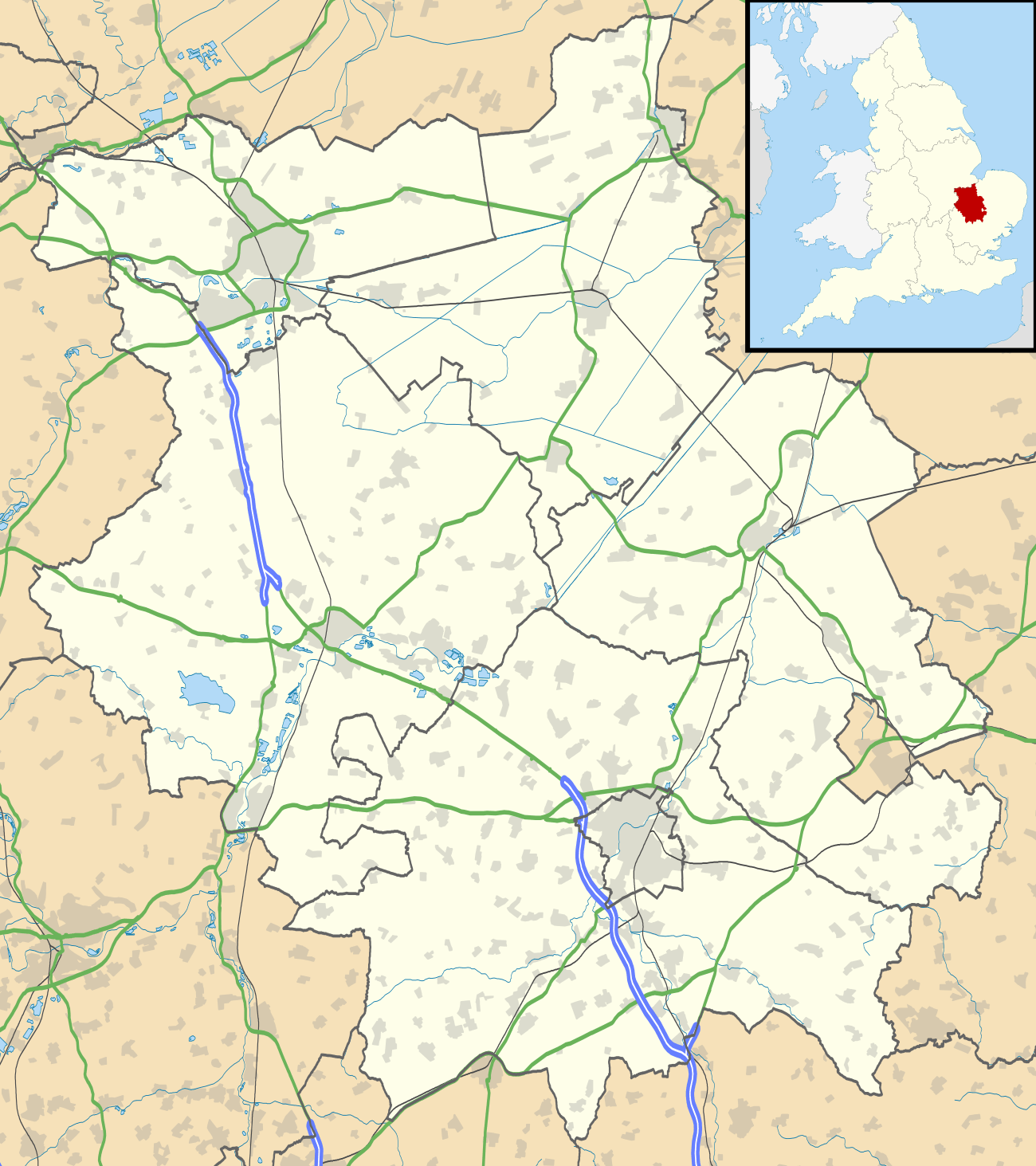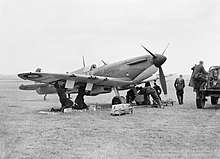RAF Fowlmere
Royal Air Force Fowlmere or more simply RAF Fowlmere is a former Royal Air Force station located 4.2 miles (6.8 km) northeast of Royston, Hertfordshire and 8.8 miles (14.2 km) southwest of Cambridge, Cambridgeshire, England.
| RAF Fowlmere USAAF Station 378 .png) | |||||||||
|---|---|---|---|---|---|---|---|---|---|
| Near Cambridge, Cambridgeshire in England | |||||||||
 Aerial photograph of Fowlmere airfield 31 May 1944, taken by 13th Photographic Squadron, 7th Photographic Reconnaissance Group | |||||||||
 RAF Fowlmere Shown within Cambridgeshire | |||||||||
| Coordinates | 52°04′57″N 000°03′31″E | ||||||||
| Type | Royal Air Force station | ||||||||
| Code | FW | ||||||||
| Site information | |||||||||
| Owner | Air Ministry | ||||||||
| Operator | Royal Air Force United States Army Air Forces | ||||||||
| Site history | |||||||||
| Built | 1940 | ||||||||
| In use | 1946-1946 | ||||||||
| Garrison information | |||||||||
| Occupants | 339th Fighter Group | ||||||||
| Airfield information | |||||||||
| Elevation | 38 metres (125 ft) AMSL | ||||||||
| |||||||||
First World War
Flying at Fowlmere originated in 1918 when the airfield was used by Royal Air Force
Flying cadets of the Air Service, United States Army were trained at Fowlmere by RAF instructors, prior to their deployment to the Western Front in France.[2] After the First World War ended, the hangars were all demolished along with the assorted buildings by 1923.
Second World War
Royal Air Force use


With the eruption of the Second World War, Fowlmere was intended to be a satellite for nearby RAF Duxford and was used by 19 Sqn with Supermarine Spitfires[3] along with:
- No. 2 Squadron RAF.[4]
- No. 15 Squadron RAF.[5]
- No. 16 Squadron RAF.[5]
- No. 21 Squadron RAF.[6]
- No. 111 Squadron RAF.[7]
- No. 133 (Eagle) Squadron RAF.[8]
- No. 154 Squadron RAF.[9]
- No. 167 Squadron RAF.[10]
- No. 174 Squadron RAF.[11]
- No. 264 Squadron RAF.[12]
- No. 411 (Canadian) Squadron RAF.[13]
- No. 421 (Canadian) Squadron RAF.[14]
- No. 655 Squadron RAF.[15]
United States Army Air Forces use




When the airfield was turned over to the USAAF, Fowlmere was expanded to meet the requirements of a complete fighter group. The airfield was assigned USAAF designation Station 378 It was allocated to the United States Army Air Forces Eighth Air Force fighter command.
USAAF Station Units assigned to RAF Fowlmere were:[16]
- 314th Service Group[17]
- 467th Service Squadron; HHS 314th Service Group
- 331st Service Group[18]
- 464th and 465th Service Squadrons; HHS 331s Service Group
- 18th Weather Squadron
- 72nd Station Complement Squadron
- 861st Engineer Aviation Battalion
- 1178th Quartermaster Company
- 1786th Ordnance Supply & Maintenance Company
- 989th Military Police Company
- 2120th Engineer Fire Fighting Platoon
The 339th Fighter Group arrived at Fowlmere from Rice AAF, California on 4 April 1944. The group was under the command of the 66th Fighter Wing of the VIII Fighter Command. Aircraft of the group were identified by a red/white chequerboard pattern.
Postwar Royal Air Force use
With the departure of the Americans, Fowlmere was used briefly by No. 11 Group RAF RAF Fighter Command until January 1946 then closed and placed into care and maintenance status. It was eventually sold back to local farmers in 1957.
Current use
With the end of RAF control, the concreted areas and buildings of Fowlmere airfield were largely ground into aggregate and sold for local construction projects.
The T-2 hangar is still in use by a local farmer and there are a few decaying huts on the west side of Fowlmere village. Other than that, there is little else to indicate previous use of the site as an active fighter airfield. Only fragments of taxi-track remain, and part of a secondary runway is used for light aircraft.[19]
Citations
- Jefford 1988, p. 58.
- "Fowlmere". controltowers.co.uk. Retrieved 8 March 2015.
- Jefford 1988, p. 30.
- Jefford 1988, p. 23.
- Jefford 1988, p. 29.
- Jefford 1988, p. 31.
- Jefford 1988, p. 56.
- Jefford 1988, p. 59.
- Jefford 1988, p. 63.
- Jefford 1988, p. 64.
- Jefford 1988, p. 65.
- Jefford 1988, p. 80.
- Jefford 1988, p. 90.
- Jefford 1988, p. 91.
- Jefford 1988, p. 103.
- "Fowlmere". American Air Museum in Britain. Retrieved 8 March 2015.
- "331st Service Group". American Air Museum in Britain. Retrieved 8 March 2015.
- "314th Service Group". American Air Museum in Britain. Retrieved 8 March 2015.
- http://www.modair.co.uk/
Bibliography
- Jefford, C G (1988). RAF Squadrons. A comprehensive record of the movement and equipment of all RAF squadrons and their antecedents since 1912. Shrewsbury: Airlife. ISBN 1-85310-053-6.
- Freeman, Roger A. (1978) Airfields of the Eighth: Then and Now. After the Battle ISBN 0-900913-09-6
- Freeman, Roger A. (1991) The Mighty Eighth: The Colour Record. Cassell & Co. ISBN 0-304-35708-1
- Maurer, Maurer (1983). Air Force Combat Units Of World War II. Maxwell AFB, Alabama: Office of Air Force History. ISBN 0-89201-092-4.
- USAAS-USAAC-USAAF-USAF Aircraft Serial Numbers--1908 to present
- mighty8thaf.preller.us Fowlmere
- 339th Fighter Group on www.littlefriends.co.uk
External links
| Wikimedia Commons has media related to Fowlmere Airfield. |
